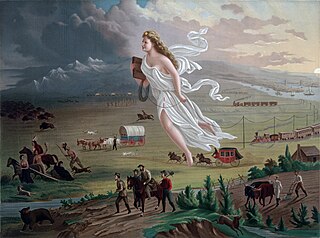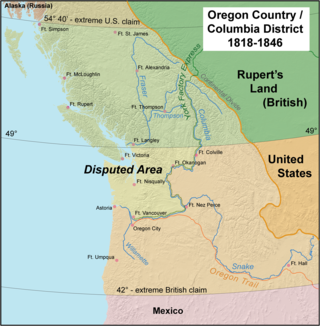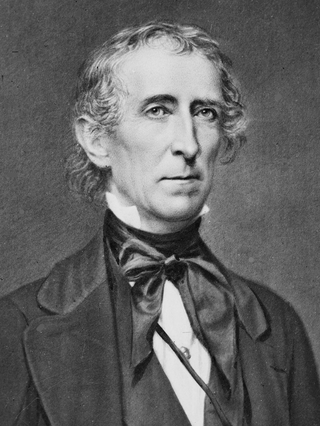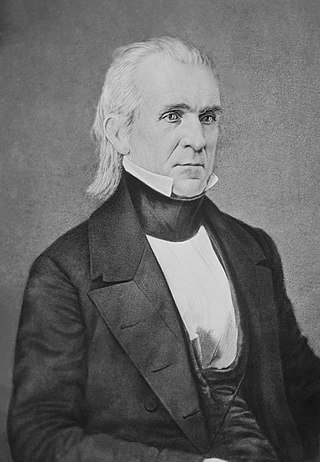Related Research Articles

James Knox Polk was the 11th president of the United States, serving from 1845 to 1849. A protégé of Andrew Jackson and a member of the Democratic Party, he was an advocate of Jacksonian democracy and extending the territory of the United States. Polk led the U.S. into the Mexican–American War, and after winning the war he annexed the Republic of Texas, the Oregon Territory, and the Mexican Cession.

The Republic of Texas, or simply Texas, was a breakaway state in North America. It existed for close to 10 years, from March 2, 1836 to February 19, 1846. Texas shared borders with Mexico, the Republic of the Rio Grande, and the United States of America. The Republic of Texas had engaged in some complex relations with various nations. The United States was one of the key players that recognized Texas's independence. However, they hesitated to annex the Republic due to domestic affairs with Mexico. European powers had extended their recognition and wanted to engage in trade with Texas. These relations were very significant and shaped Texas's republic. This had led to the annexation by the U.S. which led to the Mexican-American War.

Presidential elections were held in the United States from November 1 to December 4, 1844. Democratic nominee James K. Polk narrowly defeated Whig Henry Clay in a close contest turning on the controversial issues of slavery and the annexation of the Republic of Texas. This is the only election in which both major party nominees served as Speaker of the House at one point, and the first in which neither candidate held elective office at the time.

"Manifest destiny" is a phrase that represents the belief in the 19th-century United States that American settlers were destined to expand westward across North America, and that this belief was both obvious ("manifest") and certain ("destiny"). The belief is rooted in American exceptionalism and Romantic nationalism, implying the inevitable spread of the republican form of governance. It is one of the earliest expressions of American imperialism in the United States of America.

The Republic of Texas was annexed into the United States and admitted to the Union as the 28th state on December 29, 1845.

The Oregon boundary dispute or the Oregon Question was a 19th-century territorial dispute over the political division of the Pacific Northwest of North America between several nations that had competing territorial and commercial aspirations in the region.

The Provisional Government of Oregon was a popularly elected settler government created in the Oregon Country (1818-1846), in the Pacific Northwest region of the western portion of the continent of North America. Its formation had been advanced at the Champoeg Meetings since February 17, 1841, and it existed from May 2, 1843 until March 3, 1849, and provided a legal system and a common defense amongst the mostly American pioneers settling an area then inhabited by the many Indigenous Nations. Much of the region's geography and many of the Natives were not known by people of European descent until several exploratory tours and expeditions were authorized at the turn of the 18th to the 19th centuries, such as Lewis and Clark's Corps of Discovery going northwest in 1804-1806, and United States Army Lt. Zebulon Pike and his party first journeying north, then later to the far southwest.

The presidency of John Tyler began on April 4, 1841, when John Tyler became the 10th President of the United States upon the death of President William Henry Harrison, and ended on March 4, 1845. He had been Vice President of the United States for only 31 days when he assumed the presidency. Tyler was the first to succeed to the office without being elected to it. To forestall constitutional uncertainty, Tyler took the presidential oath of office on April 6, assumed full presidential powers, and served out the balance of Harrison's four-year term, a precedent that would govern future extraordinary successions and eventually become codified in the Twenty-fifth Amendment. He was succeeded by James Polk of the Democratic Party.

The presidency of James K. Polk began on March 4, 1845, when James K. Polk was inaugurated as the 11th President of the United States, and ended on March 4, 1849. He was a Democrat, and assumed office after defeating Whig Henry Clay in the 1844 presidential election. Polk left office after one term, fulfilling a campaign pledge he made in 1844, and he was succeeded by Whig Zachary Taylor. A close ally of Andrew Jackson, Polk's presidency reflected his adherence to the ideals of Jacksonian democracy and manifest destiny.

In the context of the United States, secession primarily refers to the voluntary withdrawal of one or more states from the Union that constitutes the United States; but may loosely refer to leaving a state or territory to form a separate territory or new state, or to the severing of an area from a city or county within a state. Advocates for secession are called disunionists by their contemporaries in various historical documents.

John Tyler was the tenth president of the United States, serving from 1841 to 1845, after briefly holding office as the tenth vice president in 1841. He was elected vice president on the 1840 Whig ticket with President William Henry Harrison, succeeding to the presidency following Harrison's death 31 days after assuming office. Tyler was a stalwart supporter and advocate of states' rights, including regarding slavery, and he adopted nationalistic policies as president only when they did not infringe on the states' powers. His unexpected rise to the presidency posed a threat to the presidential ambitions of Henry Clay and other Whig politicians and left Tyler estranged from both of the nation's major political parties at the time.

Republic of Texas–United States relations refers to the historical foreign relations between the now-defunct Republic of Texas and the United States of America. Relations started in 1836 after the Texas Revolution and ended in 1845 upon the annexation of Texas by the United States.
The 1842 State of the Union Address, was written by John Tyler, the tenth president of the United States. It was presented on Tuesday, December 6, 1842, by the Clerk of the United States House of Representatives. He said, "We have continued reason to express our profound gratitude to the Great Creator of All Things for numberless benefits conferred upon us as a people. Blessed with genial seasons, the husbandman has his garners filled with abundance, and the necessaries of life, not to speak of its luxuries, abound in every direction."

The history of U.S. foreign policy from 1829 to 1861 concerns the foreign policy of the United States during the presidential administrations of Andrew Jackson, Martin Van Buren, William Henry Harrison, John Tyler, James K. Polk, Zachary Taylor, Millard Fillmore, Franklin Pierce, and James Buchanan. During this era, the United States annexed the Republic of Texas, acquired the Mexican Cession by defeating Mexico in the Mexican–American War and partitioned Oregon Country with the United Kingdom of Great Britain and Ireland. The period began with the inauguration of Jackson in 1829, while the onset of the American Civil War in 1861 marked the start of the next period in U.S. foreign policy.

The 1831 State of the Union Address was delivered by the seventh president of the United States, Andrew Jackson, on December 6, 1831, to the 22nd United States Congress. In his third annual message, Jackson highlighted the continued prosperity of the United States, focusing on agricultural success, growth in manufacturing, and advancements in internal improvements. He credited these developments to the nation's free institutions and stressed the importance of maintaining the Union.
The 1833 State of the Union Address was delivered by the 7th president of the United States, Andrew Jackson, on December 3, 1833, to the 23rd United States Congress. In this address, Jackson celebrated the nation's prosperity and expressed optimism about the continued peace and health of the country, as well as the flourishing of its commerce and industry.
The 1839 State of the Union Address was delivered by the 8th president of the United States Martin Van Buren to the 26th United States Congress on December 2, 1839. Van Buren opened by noting that while the country had experienced several challenges, including fires, disease, and ongoing trade difficulties in key cities, the nation continued to benefit from prosperity in agriculture. He praised the season's abundant harvests, noting that “no means of individual comfort is more certain and no source of national prosperity is so sure” as agriculture.
The 1841 State of the Union address was delivered by the 10th president of the United States John Tyler on December 7, 1841, before the 27th United States Congress.
The 1843 State of the Union address was delivered by the 10th president of the United States John Tyler to the 27th United States Congress on December 5, 1843. In this address, President Tyler spoke of America's overall prosperity and stability, crediting "the superintendence of an overruling Providence" for guiding the nation through its many trials. Tyler's remarks emphasized the nation's peace, rising trade and commerce, and the abundance of agricultural production in 1843, which together had contributed to economic revival following the financial instability of prior years.
The 1845 State of the Union Address was presented by President James K. Polk to the 29th United States Congress on December 2, 1845.
References
- ↑ "Joint Meetings, Joint Sessions, & Inaugurations | US House of Representatives: History, Art & Archives". history.house.gov. Retrieved 2 November 2024.
- 1 2 3 "John Tyler - State of the Union Address -- 1844". The American Presidency Project. Retrieved 19 October 2024.
- ↑ "History of Texas Annexation". Texas State Historical Association. Retrieved 19 October 2024.